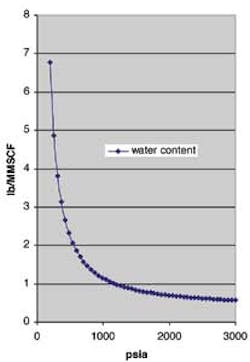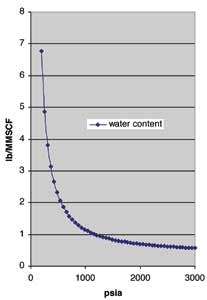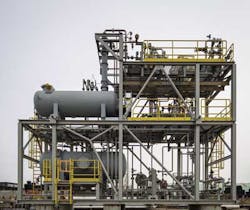Optimizing dehydration unit critical to gas lift
Shuo Wang
Fluor Corp.
For years, offshore operators have faced the inevitable prospect of well depletion, in both hemispheres and from shallow to deepwater. Over the course of a well's productive life, typically 25 years, all fields will experience this cycle, from an original high energy state characterized by high reservoir pressures to a depleting energy state that is no longer worth recovery efforts. If there is not enough energy in the form of reservoir pressure to overcome surface and hydrostatic pressure in the wellbore, petroleum liquids will not flow to the surface regardless of the amount in the reservoir.
When properly applied, well-conditioned and treated lift gas can lower the overall wellbore hydrostatic pressure, and mitigate hydrate formation to enhance and prolong the overall productivity of each well in its later life phases. Lift gas is often required to maintain production over the life of a producing well, and can also be applied for riser slug mitigation. With appropriate design, gas lift can be applied at any water depth, and even in harsh environmental conditions.
Gas lift is the most economical oilfield practice for enhancing recovery, but to be most effective, the gas has to be well-treated, and contain minimal or zero water content. Water saturation has several real and potentially adverse effects. It adds more hydrostatic pressure in the wellbore, thus dissipating the reservoir pressure. It can also lead to the formation of hydrates that will impede flow, which in turn leads to greater field operating costs.
The untreated gas employed for gas lift is usually the associated gas from the well. It is often saturated with water content, especially offshore. If not conditioned properly, the gas hydrates may form in any part of the lift gas where water content and appropriate temperatures and pressures exist. The saturated water has to be knocked out to prevent line plugging.
This is where a smaller, low-cost but still effective dehydration unit comes in. Newer dehydration designs, which feature a lower pressure, can employ a smaller unit to reduce costs and topsides footprint, while reducing water in the lift gas, and delivering the same enhanced recovery results.
The goal here is to suggest a low-cost solution to enhance recovery from depleted wells. It focuses on a single pivotal principal element, which is the process parameter for optimizing the dehydration of the lift gas. This design is used in offshore gas lift applications, and is proven effective in enhancing process performance, reducing initial and operating costs, and maximizing the overall economic outcome.
Dehydration unit basics
A dehydration unit is composed of several pieces of processing equipment – contactor, flash drum, tower, heat exchangers, and glycol pumps – all integrated for the purpose of eliminating the water content which inherently permeates untreated processing gas streams. By lowering the processing temperature to the water dew points, moisture content can be expected to be condensed for ultimate removal.
An adequate dehydration process, when applied to the intended gas streams below the dew point, will effectively prevent hydrate formation and mitigate subsequent potential corrosion risk caused by the condensed water. Corrosion risk must be mitigated and reduced to a minimal level for any gas streams containing CO2 or H2S. These gases are acidic, and when combined with condensed water, can lead to corrosion of the process facilities.
The most common process for dehydrating natural gas is to intermingle the gas with a hygroscopic liquid such as one of the glycols. This is an absorption process. The water vapor in the gas stream dissolves in a relatively pure glycol liquid solvent stream.
Saturated gas intermingles with glycol through an enclosed vessel (a glycol contactor or absorber), and then the treated gas either becomes sales gas or lift gas. The rich glycol undergoes a pressure drop and exchanges heat with the still column overhead condenser; lean glycol then flashes out some of the dissolved hydrocarbons and passes through the filtration.
After that, the rich glycol exchanges heat again with lean glycol and then heads to the reboiler. Lean glycol exits the reboiler and exchanges heat with rich glycol, then goes to the glycol pump and is pumped back to the glycol contactor.
There are a number of independent process variables (PVs) directly affecting the process outcome. These variables are glycol, effective temperature, glycol concentration, reboiler temperature and pressure, and glycol circulation rate in this unit.
However, the goal here is to focus on the key process parameters that help offshore operators optimize their conditioning system, and thereby enhance the performance of their topsides process equipment. The overall goal is to reduce initial and operating costs, and eventually to maximize the economic outcome.
Effective pressure
Pressure is an important process parameter which impacts the initial cost and the operational cost of the whole system. There are three primary reasons. First, it determines the wall thickness of the process vessel and its associated piping, fittings, and appurtenances. Second, it determines the size of the pump and compressor head. Third, it indirectly determines the size of the system. Thus, the key to optimizing the size of the dehydration unit is finding the most effective pressure for the glycol contactor.
The glycol contactor pressure has little effect on glycol absorption as long as the pressure remains below 3,000 psig. At a constant temperature, the water content of the inlet gas decreases with increasing pressure; thus less water must be removed. In addition, a smaller-sized glycol contactor can be used, since the actual velocity of the gas is lower. On the other hand, the higher the pressure, the thicker the steel wall needs to be for a given diameter.
Selecting an effective pressure is complicated. There are numerous factors to take into account. These include the size of the system, wall thickness and size of the column, circulation rate, piping class, pump selection, and compressor selection. In most cases, a range of 500 to 1,200 psig is the most economical production mode for the whole system.
Effective operating temperature
Effective operating temperature (EOT) is a vital process parameter that impacts the initial capex, the operational costs, and the operating efficiency of the whole processing system. There are three primary reasons. First, this EOT determines the efficiency of the energy usage. Second, this same EOT determines the saturated water content which is the system capacity. Third, this EOT indirectly determines the output productivity of the system. Establishing an effective operating temperature is critical to the dehydration unit.
Inlet gas temperature
At constant pressure, the water content of the inlet gas increases as the inlet gas temperature increases. At a higher temperature, the unit weight of glycol has to remove more water to meet the same pipeline specification. Also, an increase in the gas temperature may result in an increase in the glycol contactor diameter. Inlet gas temperature above 120°F may result in the significant glycol losses. Below the 60°F-to-70°F range, glycol can form a stable emulsion with the liquid hydrocarbons in the gas, which can then lead to foaming. Foam is highly undesirable because it reduces the efficiency of the dehydration unit.
Lean glycol temperature
Lean glycol temperature cannot be excessively hot or excessively cold. There are a number of reasons for this requirement. First, an undue amount of glycol losses to the under-processed gas in the glycol contactor may occur when the lean glycol temperature gets excessively hot. On the other hand, the lean glycol temperature should be kept slightly above the inlet gas temperature to prevent hydrocarbon condensing. Balancing these two conflicting temperature parameters must be well assessed and assured from experience.
Hydrate point
Gas hydrates are clathrate hydrates (a class of solid hydrates of gases): water ice with gas molecules trapped within. When the gas is methane, it is called a methane hydrate.
Nonpolar molecules such as methane can form clathrate hydrates with water, especially under high pressure. Although there is no hydrogen bonding of water molecules when methane is the guest molecule of the clathrate, guest-host hydrogen bonding often forms with guest molecules in clathrates of many larger organic molecules, such as tetrahydrofuran. In such cases, the guest-host hydrogen bonds result in the formation of L-type Bjerrum defects in the clathrate lattice.
The higher the glycol concentration, the greater the dew point depression for a determined glycol circulation rate and number of stages. The leaner the lean glycol, the lesser possible water content in the vapor phase. Therefore, the lower the water content is for a determined equilibrium curve. Consequently, hydrate will form before water dews.
Conclusion
Depending on the design conditions and the purpose of the processed gas, pressure manipulation (or handling) can be expensive. At the same time, it is a vital operating parameter for any offshore facility with gas processing equipment, due to the complex and often conflicting array of process variables involved. As mentioned earlier, operators often face challenges when siting the dehydration unit on the platform topsides, due to the limited availability of space and accessibility requirements.
However, lower design pressures can enable operators to reduce the size of the processing unit, thereby reducing costs and equipment footprint. For example, the current footprint for the newer design is 5 m x 9 m (16 ft x 29.5 ft), compared to 70 m x 22 m (230 ft x 72 ft) for the older ones. This reduced footprint frees 16,092 sq ft (1,495 sq m) on the topsides platform. These newer, smaller dehydration units deliver the same gas lift and production results.
There are additional process parameters to consider. First, a range of 80°F to 110°F is recommended for the inlet gas temperature. Second, the temperature of the tri-ethylene (TEG) at the inlet of glycol contactor should be higher than that of the dry gas in the tower outlet. Third, the water inherently contained in the processing gas streams must dew out before hydrates form. Fourth, it should be noted that the hydrate cannot form under an ultra-high pressure condition (in the supercritical region). In this case, there is no need for a dehydration unit at all.


